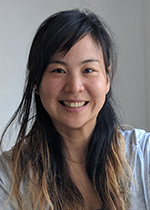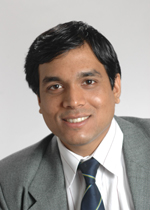BEARS 2022: Presentations

Alexandre M. Bayen
Expanding Opportunities at Moffett Field
This talk will discuss new opportunities to expand UC Berkeley’s footprint in the Bay Area at Moffett Field, the home of NASA Ames. The talk will describe the academic innovation process leading to the creation of new academic units by campuses in different geographic locations, to expand their capabilities. The talk will cover the specific case of NASA Ames for Berkeley, and describe some of the aspirations of UC Berkeley in developing activities at Moffett Field in connection with NASA Ames.
BIO: Alexandre M. Bayen is the EECS Liao Cho Professor of Engineering, the Director of the Institute for Transportation Studies (ITS), and the Associate Provost for Moffett Field Program Development. His research focuses on the modelling and control of distributed parameters systems: large scale infrastructure systems, transportation, and water distribution. He holds a joint appointment in the Department of Civil and Environmental Engineering, is a Faculty Scientist in Mechanical Engineering at LBNL, and is affiliated with the California Partners for Advanced Transportation Technology (PATH) lab, the CITRIS People and Robots (CPAR) lab, the Berkeley Artificial Intelligence Research (BAIR) lab, Berkeley Deep Drive (BDD), and the Foundations Of Resilient CybEr-physical Systems (FORCES). After stints as a visiting researcher at NASA Ames Research Center, and as the Research Director of the Autonomous Navigation Laboratory at the Laboratoire de Recherches Balistiques et Aerodynamiques in France, Bayen joined the Berkeley faculty in 2005. He earned an Engineering Degree in applied mathematics from the Ecole Polytechnique, France (1998), and an M.S./Ph.D. in aeronautics and astronautics from Stanford University (1999/2003).

Angjoo Kanazawa
Perceiving Humans in the 3D World
We live in a 3D world that is dynamic and full of life, with people and animals interacting with each other and the environment. Capturing this complex world in 3D from everyday images or video has a huge potential for many applications such as marker-less motion capture from your phone, compelling mixed reality applications that can interact with people and objects, novel content creation tools for artists, robots that can learn to act by visually observing people, and applications in biometrics, health care, and more. In this short talk, I will discuss the current state-of-the-art in the area of 3D human perception from everyday images and video.
BIO: CS Assistant Prof. Angjoo Kanazawa leads the Kanazawa AI Research (KAIR) lab in the Berkeley Artificial Intelligence Research (BAIR) center. Her research lies at the intersection of computer vision, computer graphics, and machine learning, and she is focused on figuring out how to build a system that can use everyday photographs and videos to perceive and understand the dynamic, complex, interactive, 3D world in which we live. She is a Research Scientist at Google Research and serves on the advisory board of Wonder Dynamics. Kanzawa holds a B.A. in Mathematics from NYU and a Ph.D. in Computer Science from the University of Maryland, College Park. She worked at Berkeley as a BAIR postdoctoral researcher for two years under the supervision of Jitendra Malik, Alexei A. Efros and Trevor Darrell.

Eric Paulos
Plastic Dynamism: Delightful Decomposition, Destruction, Decay, Deformation, and Digestive Designs
This talk will briefly present and critique a new body of evolving collaborative work at the intersection of art, computer science, material science, and design research. I will present an argument for hybrid materials, methods, and artifacts as strategic tools for insight and innovation within computing culture. The narrative will interrogate a series of early research moving toward two primary themes – Unmaking and Hybrid Dynamism. The access and growing ubiquity of digital fabrication has ushered in a celebration of creativity and “making.” However, the focus is often on the resulting static artifact or the creative process and tools to design it. In this talk, I describe a post-making process that extends past these final static objects — not just in their making but in their “unmaking.” By drawing from artistic movements such as Auto-Destructive Art, intentionally inverting well-established engineering principles of structurally sound designs, and safely misusing unstable materials, this talk will demonstrate an important extension to making — unmaking. Unmaking allows designs to change over time, is an ally to sustainability and re-usability, and captures themes of “aura,” emotionality, and personalization. I will also describe an exploration into Hybrid Dynamism – the design of novel interactive electronic systems that leverage novel materials that are both dynamic and entirely decomposable.
BIO: CS Prof. Eric Paulos is the Director of the Hybrid Ecologies Lab, Director of the Master of Design (MDES) program, Acting & Associate Director of the Jacobs Institute for Design Innovation, Director and Co-Founder of the CITRIS Invention Lab, Co-Director of the Swarm Lab, and affiliated with the Berkeley Center for New Media (BCNM). His research focuses on the design, construction, deployment, hardware, and software evaluation of novel physical devices and interactive systems in real world settings. His work draws as much from art, culture, and critical design theory as it does computer science, and is grounded in user-centered design methods via field observations, participatory studies, and interviews with user communities. Before joining the Berkeley faculty, Paulos was a senior research scientist at Intel Research, and a professor at the Carnegie Mellon Human-Computer Interaction Institute with courtesy appointments in the Robotics Institute and in the Entertainment Technology Center. He helped launch a new robotic industry by developing some of the first internet tele-operated robots while earning his Ph.D. from Berkeley in 2001 (advisor: John Canny).

Sanjit Seshia
Design Automation for Autonomous Intelligent Cyber-Physical Systems
Cyber-physical systems (CPS) integrate computation with physical processes. The past decade has seen tremendous growth in autonomous and semi-autonomous CPS, including autonomous vehicles and robotics, enabled by innovationsin artificial intelligence (AI) and machine learning. However, the wider deployment of such autonomous intelligent CPS (AI-CPS) is being held back by the limitations of current technology with respect to safety, reliability, and robustness. This talk will present a vision for a new generation of design automation techniques, rooted in formal methods, to enable the development of high assurance AI-CPS. I will describe our work on the design and verification of intelligent cyber-physical systems, implemented in the open-source Scenic and VerifAI toolkits, with a particular focus on deep learning-based autonomy in ground and air vehicles. Our vision is to facilitate the computer-aided design of safe and robust AI-CPS in a manner similar to that enabled today for integrated circuits by tools for electronic design automation.
BIO: EECS Prof. Sanjit A. Seshia’s research interests are in formal methods for dependable and secure computing, with a current focus on the areas of cyber-physical systems, computer security, machine learning, and robotics. He has made pioneering contributions to the areas of satisfiability modulo theories (SMT), SMT-based verification, and inductive program synthesis. He is co-author of a widely-used textbook on embedded, cyber-physical systems and has led the development of technologies for cyber-physical systems education based on formal methods. His awards and honors include a Presidential Early Career Award for Scientists and Engineers (PECASE), an Alfred P. Sloan Research Fellowship, the Frederick Emmons Terman Award for contributions to electrical engineering and computer science education, the Donald O. Pederson Best Paper Award for the IEEE Transactions on CAD, the IEEE Technical Committee on Cyber-Physical Systems (TCCPS) Mid-Career Award, and the Computer-Aided Verification (CAV) Award for pioneering contributions to the foundations of SMT solving. He is also a Fellow of the ACM and the IEEE. Seshia received a B.Tech. in Computer Science and Engineering from the Indian Institute of Technology, Bombay (1998) and an M.S. and Ph.D. in Computer Science from Carnegie Mellon University (2000/2005).

Allen Yang
Berkeley Robot Open Autonomous Racing (ROAR): Advancing Vehicle Autonomy for Extreme Scenarios
Autonomous driving has been a hot topic in research and automobile markets. Prediction of when L5 full auto driving may become reality varies widely in the industry. In the meantime, both academia and industry are challenged about how to close the technical gap for ensuring the vehicle safety for extreme but small probability scenarios. In this talk, I will discuss a project that offers rich research and educational tools for academia and industry alike to better study vehicle autonomy for extreme scenarios, called ROAR. ROAR offers reference hardware and software design that allow researchers to effectively conduct their research with minimal material cost and time overhead to rewrite core algorithms in machine learning and computer perception. Use cases with partnering universities, companies, and Indy Autonomous Challenge will also be presented
BIO: Allen Yang is an EECS Assistant Research Engineer, and is the Executive Director of both the Center for Augmented Cognition and the FHL Vive Center for Enhanced Reality. His research is in the area of high-dimensional pattern recognition, computer vision, and image processing, and includes applications in motion segmentation, image segmentation, face recognition, and sensor networks. He served as Chief Scientist of the Fung Institute for Engineering Leadership in 2016, co-founded Grafty, Inc., and served as CTO and Acting COO of Atheer Inc. Yang has published four books/chapters, 14 journal papers and more than 30 conference papers, and holds 12 US patents/applications. He earned his B.E. in CS from the University of Science and Technology of China, Hefei (2001), an M.S. in EE (2003), M.S. in Mathematics (2005) and Ph.D. in Electrical and Computer Engineering (2006), all from the University of Illinois at Urbana-Champaign.